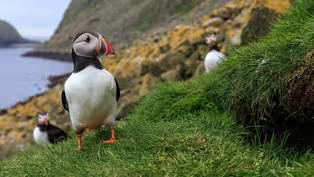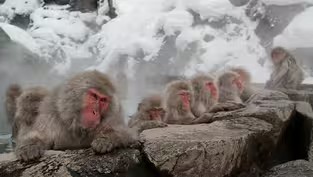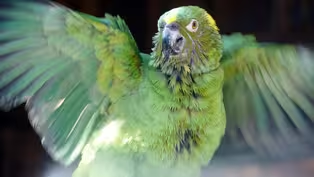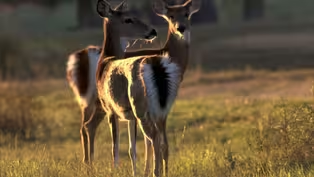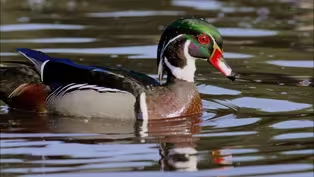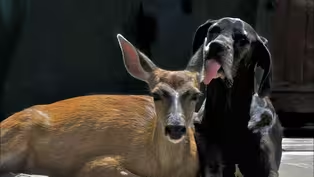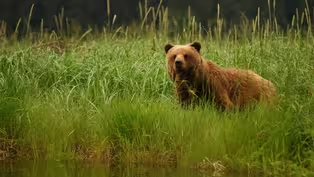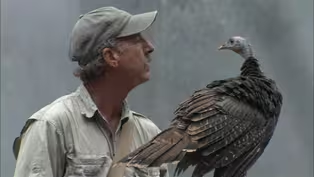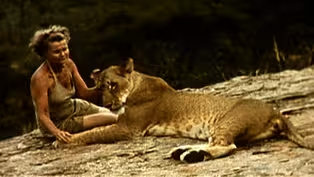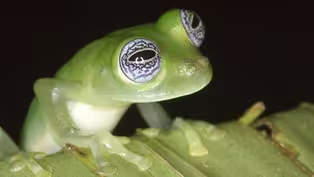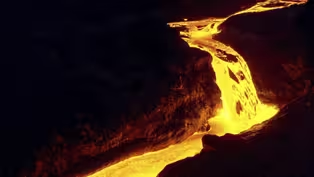
Echoes from the Ice
Season 12 Episode 3 | 55m 2sVideo has Closed Captions
The walls of ice in Glacier Bay surround the most beautiful sights Alaska has to offer.
The two-hundred-foot walls of ice in Glacier Bay overwhelm the senses, but they also surround the most beautiful sights Alaska has to offer -- the Northern Lights, roaming grizzly bears, and humpback whales. The glacier itself is also creating new life -- it has retreated some 70 miles up the bay, wiping the ecological slate clean, allowing new plants and animals to start again from scratch.
Problems playing video? | Closed Captioning Feedback
Problems playing video? | Closed Captioning Feedback
Major support for NATURE is provided by The Arnhold Family in memory of Henry and Clarisse Arnhold, Sue and Edgar Wachenheim III, The Fairweather Foundation, Charles Rosenblum, Kathy Chiao and...

Echoes from the Ice
Season 12 Episode 3 | 55m 2sVideo has Closed Captions
The two-hundred-foot walls of ice in Glacier Bay overwhelm the senses, but they also surround the most beautiful sights Alaska has to offer -- the Northern Lights, roaming grizzly bears, and humpback whales. The glacier itself is also creating new life -- it has retreated some 70 miles up the bay, wiping the ecological slate clean, allowing new plants and animals to start again from scratch.
Problems playing video? | Closed Captioning Feedback
How to Watch Nature
Nature is available to stream on pbs.org and the free PBS App, available on iPhone, Apple TV, Android TV, Android smartphones, Amazon Fire TV, Amazon Fire Tablet, Roku, Samsung Smart TV, and Vizio.
Buy Now
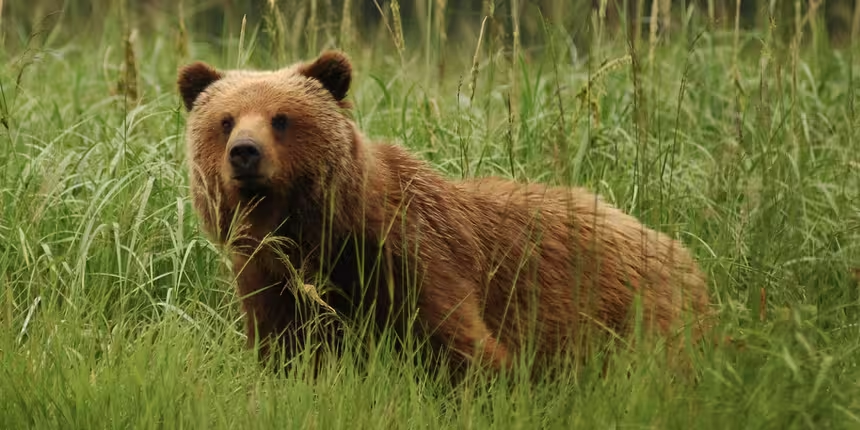
Explore More Ways to Watch
Bring the beauty and wonders of wildlife and natural history into your home with classic NATURE episodes.Providing Support for PBS.org
Learn Moreabout PBS online sponsorshipMore from This Collection
Watch classic NATURE episodes with the PBS station member benefit Passport.
Video has Closed Captions
Animals congregate in huge colonies partly out of necessity and partly for the security. (52m 55s)
Video has Closed Captions
Follow a troop of snow monkeys in Japan to see how they prepare to face the world. (52m 58s)
Video has Closed Captions
Parrots and the bittersweet world they share with humans. (53m 10s)
Video has Closed Captions
Learning about one of our closest neighbors: the white-tailed deer. (53m 10s)
Video has Closed Captions
Take a fascinating look at one of our most familiar birds. (1h 42s)
Video has Closed Captions
Love apparently knows no boundaries in the animal kingdom. (53m 20s)
Video has Closed Captions
Enter a world shaped by bears, trees, and salmon. (50m 9s)
Video has Closed Captions
One man's remarkable experience of raising a group of wild turkey hatchlings to adulthood. (58m 51s)
Elsa's Legacy: The Born Free Story
Video has Closed Captions
The true story that inspired "Born Free". (53m 10s)
Video has Closed Captions
It is the greatest mass extinction since the dinosaurs. (53m 43s)
Video has Closed Captions
Kilauea, on Hawaii's Big Island, is the world's most active volcano. (54m 6s)
Video has Closed Captions
Relationships with cats and dogs are some of the longest and most intimate of our lives. (53m 30s)
Providing Support for PBS.org
Learn Moreabout PBS online sponsorship[bears roaring] [dramatic music] - [Narrator] The rugged coast of Alaska, a wilderness that's young and raw, and still in motion.
And all its splendor has emerged from a cold and hostile force.
Ice Glaciers have sculpted Southeast Alaska with a hard hand.
And though the Ice Age is over now, glaciers still march down to the sea.
They are the force of change, of destruction and creation.
And the Alaskan coast still resounds with the breaking thunder of the ice.
[ice crashing] [water splashing] [bright music] [elephant honking] - [Announcer] Nature is made possible by the Corporation for Public Broadcasting and by annual financial support from viewers like you.
[soft music] - [Narrator] In the old days, the people knew how the world moved.
It flowed between liquid and solid, between sunlight and darkness, between the land and the sea.
Spirits were everywhere.
And one of the greatest lived in the winter wind.
This was the breath of the ice spirit, the ghost of the glaciers, a spirit so strong, it could defy the sun.
Sweeping in from the sea, the wind unleashed a great force on the mountains, falling.
It covered everything.
This is Southeast Alaska, the home of the Tlingit people.
The Ice Age that once buried this land is over, but its legacy remains in a landscape reborn and bursting with life.
[upbeat music] [birds chirping] [water rushing] [water dripping] [dramatic music] [birds calling] [water splashing] The snow-covered peaks of Southeast Alaska plunge into deep fjords and forested islands spill out from the coast.
Immense ice fields still embrace the mountains.
The ice stretches, bends, and splits into deep crevasses as it moves over the Earth's surface far below.
[wind howling] Flake upon flake, layer upon layer, the snow accumulates.
The weight of each storm causes the underlying snow to recrystallize into dense ice.
Under pressure, the ice flows like syrup.
A glacier is born.
[soft music] A Tlingit story tells how the ice came to Glacier Bay.
A young Tlingit woman saw the face of a handsome man in the ice, and called him down to her.
The glacier advanced to meet her.
All the people fled except the young woman, who was claimed by the ice.
Glaciers are not as cold as they might seem.
Remarkably, in the precarious balance between solid and liquid, there's life.
Tiny, needle-sized ice worms live inside glaciers and feed on algae.
They protect themselves from freezing by altering the fluids within their cells.
In winter, the glacier surface freezes, forcing the worms to descent deeper into the ice for warmth.
[solemn music] Inside the glacier, water works its magic.
Melting ice forms eerie subterranean sculptures.
Depending on its location,.
the ice itself could be 50 years old or 500.
It might have come from snow falling during the Second World War or while Shakespeare penned his plays.
These rivers of ice can move mountains.
Whether shrinking or expanding, all glaciers are on the move.
When more snow falls in wetter than melts in summer, glaciers grow larger and plow forward.
Beneath them, they scour the bedrock.
They transport the mountains, rock by rock, grinding them into a fine sediment called glacial flour.
[water rushing] Where the glaciers end, the rivers begin.
Cutting and braiding through the mountains, carrying away vast quantities of silt and debris.
In many rivers, like the Stikine, the glacial sediment creates a broad delta.
These tide flats form vast, fertile fields, brimming with food.
[birds clamoring] In spring, western sand pipers stop over on their way from Central and South America to summer nesting grounds in the Arctic.
Following a subtle choreography, a flock of thousands banks and wheels as one.
[upbeat music] [happy music] [geese honking] Migrating snow geese arrive as well.
Their calls echo with the promise of spring.
Far above the busy life of the deltas, the glaciers continue their imperceptible movement.
Some reach all the way to the sea, stretching into narrow fjords, like fingers into a glove.
Others fill into the open ocean from coastal valleys.
Wherever they confront the sea, the rivers of ice start to crumble.
Icebergs create perfect nurseries for thousands of harbor seals.
Their home, however, is a battlefield, where glaciers challenge the sea in a deafening clash of titans.
[ice crashing] Undermined by currents and tides, walls of ice 300 feet high collapse and hit the water with a roar the Tlingits called white thunder.
[ice thundering] [water splashing] The churning waters are thick with silt and sediment.
The harbor seals use all this chaos as cover.
Their enemies, killer whales, find it hard to hunt with all the noise and the floating ice.
[ice crashing] The ice is swept away by the rushing tide.
The narrow inlets intensify the ebb and flow, creating tides that can rise 20 feet in six hours.
[gulls cawing] Glaucous-winged gulls feast on small organisms flush to the surface.
The melting glacier adds tremendous amounts of fresh water to the inlets.
Freshwater is lighter than salt water and flows out along the surface of the fjord.
Sea water is drawn in along the bottom from the ocean.
Like a giant treadmill, this circular flow brings a constant supply of nutrients into the fjord.
[soft music] The long days of summer bathe the land and ocean in 19 hours of sunlight.
Forests of bull kelp flourish in the green waters.
The sea is thick with tiny floating plants and animals.
As constant as the moon and sun, the rhythms of the tides never cease.
Tidal currents wash through the kelp beds, bringing food to the tentacles of the cribrinopsis anemone.
[otherworldly music] A strange gallery of otherworldly creatures inhabits the cold deaths.
The juvenile king crab, the sturgeon poacher, the Irish Lord.
Glaciers are at the heart of this living system.
The rivers of ice slowly carve the fjords, churning currents saturate the waters with nutrients.
And gradually, a community develops along a coast that once was barren.
[water splashing] Sea otters revel in these frigid waters.
Unlike seals and whales insulated by layers of fat, sea otters rely on their luxurious fur coats for warmth.
The thick fur needs constant grooming to maintain its insulating abilities.
Sea otters hunt in the kelp forests and bring a catch of crabs to the surface to dine.
On warm, sunny days, they raft together in small groups, basking, grooming, and playing with the pups.
[otter growling] [water splashing] [light music] Schools of herring, sand lance, capelin, and other small fish congregate in these rich waters.
Their numbers attract great ocean wanderers from across the world.
[whales calling] Humpback whales.
[happy music] [water splashing] The humpbacks have come all the way from the tropical waters of Mexico and Hawaii.
They spend the winter in warm, clear seas where they breed and give birth.
But as the year swings into summer, the humpbacks head for these cold waters of Alaska.
They cross thousands of miles of ocean, navigate maze of fjords and islands, often homing in on precisely the same feeding spots each summer.
[fin slapping] [water splashing] [soft music] Occasionally, these graceful giants seem to think they have wings.
Just why whales breach is something of a mystery.
They may be announcing their presence on the feeding grounds or simply expressing high spirits.
[blowholes spraying] Having fasted for months, the whales arrive with voracious appetites.
These freezing waters are the ocean's refrigerator, and the whales have come to raid it.
They feast on krill and small fish, devouring as much as a ton a day.
Frequently, they feed in groups, usually led by a female and her offspring.
With elaborate teamwork, these 40 ton predators stalk their four ounce prey.
To harvest schools of herring, humpbacks use a remarkable technique called bubble netting.
The lead whale dives below the herring and swims in an upward spiral, exhaling of frothy net of bubbles around the school.
The whales may also be stunning the fish with their eerie, high pitched calls.
In panic, the school tightens.
The trap is set.
[water splashing] The maneuver is beautifully synchronized, with each member of the team maintaining its position lunge after lunge.
Bubble net feeding is an ingenious trick.
The whales actually use air and sound as tools to snare their quarry in an effervescent trap.
And when they finish, their gear disappears, leaving no trace behind.
[soft music] The day ends in a flush of crimson and gold, but it's just a prelude to the colors of the night.
Far above the ice, unearthly veils of light flash and shimmer across the sky.
[reverent music] This is the Aurora Borealis.
These Northern Lights appear when the sun blows low energy particles across the Earth's magnetic field.
The collision of the charged particles with the atmosphere ignites the sky To the Tlingit people, these celestial fires were the heroic spirits of dead warriors blazing in the heavens.
With the coming of the dawn, the auroras fade away, revealing a land locked and ice.
The mighty glaciers continue their work, time and gravity are their only masters.
Like colossal conveyor belts, they carry tremendous loads of rock and gravel down the slopes.
As they crawl along, they turn up a steady stream of rough sediment, eroding in some places, depositing in others.
Glaciers bulldoze down the valleys, creating ridge-shaped land forms called moraines.
The moraine serve as protective buffers, enabling the glacier to plow its way into the ocean.
[rocks clattering] Stone and silt dumped into the water shore up the base of the glacier and protect it from the erosive forces of salt water.
Despite its immense power, the glacier is extremely vulnerable.
If it loses contact with its protective moraine, it is doomed and will retreat rapidly up the bay.
Glaciers can retreat with dramatic speed, shrinking as much as half a mile each year.
In it's wake, the glacier leaves a devastated, barren landscape.
Out of this rubble, life must begin anew.
The first plants to arrive are carried in by the wind.
Dryas is a hardy plant that overcomes the absence of nutrients in the soil by absorbing nitrogen directly from the air.
Alder can perform this feat as well.
And as it spreads along the slopes, the soil is enriched.
Alder reproduces rapidly.
And within a decade or two, it is flourishing in dense thickets.
Ironically, each new species changes the environment in ways that eventually lead to its own demise.
Sitka spruce take advantage of the environment provided by the groves of alder.
And soon they begin to win the race for light and space.
With each successive stage of development, the diversity of plants increases.
As the generations pass, a thriving temperate rainforest emerges.
[light music] The clouds that once brought snow and built glaciers here now saturate the forest with nourishing rain.
[rain pouring] [birds chirping] The final chapter of the story sees the mature rainforest drowning in its own productivity.
As golden mosses slowly blanket the forest, they soak up the abundant rainfall.
Gradually, the ground becomes waterlogged and gives way to a stagnant community called muskeg.
With the formation of these bogs, the exquisite process of regeneration grinds to a halt.
In all this water, organic matter can no longer decompose.
These bogs may lie unchanged for centuries, waiting for the next glacier to wipe the slate clean.
On a geologic time scale, the glaciers race up and down the fjords, each time changing the landscape and creating new places for animals to live.
Mountain goats are quick to move into new areas following a retreating glacier.
With their padded hooves and calm dispositions, they're at home in this vertical world.
[gulls cawing] Few animals can navigate the steep fjord walls, which is precisely the reason black-legged kittiwakes come here to nest.
The sheer, rocky cliffs, vast ice fields, and the open ocean create formidable barriers.
The birds have little to fear from predators.
Remarkably, a few species of amphibians have arrived, such as these boreal toads.
They spent the first part of their lives as eggs and tadpoles.
Now they emerge from the lakes and ponds to feast on the abundant insects.
Few predators eat the toads since they contain a potent toxin beneath their skin.
Their first obstacle is the thousands in their own generation.
As the glaciers retreated, moose found their way into many parts of Southeast Alaska.
They come looking for the pioneer plants that spring up near the glaciers.
These young bulls in Glacier Bay are trailblazers, searching for stands of their favorite food, alder and willow.
[water rushing] The burgeoning forest filters the constant rain, and soon streams run crystal clear.
All is ready for a momentous event in the glacier story, the arrival of the salmon.
Salmon bring the richness of the sea back into these cold rivers.
They're returning to the streams of their birth to spawn.
Long ago, they made the Tlingit a wealthy people.
The Tlingit believed that salmon were a large and powerful tribe organized into five clans, chinook, coho, humpback, dog, and sockeye.
Salmon streams were family possessions passed down for generations.
But the Tlingit were never the only fishermen here.
Most black bears in Alaska survive on a vegetarian diet of roots, shoots, and berries.
But here on the coast, they fish for salmon.
The high concentration of bears leads to a pecking order at the best fishing holes, the more dominant bears claim the prime sites.
This young bear is forced to work in the rapids, and is discovering that location is everything.
The salmon challenge the rapids and then retreat back into the eddies to rest.
They've almost completed their journey home.
How many fish will make it to the spawning grounds depends partly on how many bears can fill their bellies.
A young cub appears overwhelmed by the scene, but catches on quickly.
The young bear in the rapids still comes up empty.
The rivers are choked with salmon and the bears can afford to be picky eaters.
They savor the fatty brains and roe, and frequently throw the rest away.
At last, the young bear gets the better of the rushing waters.
As the glaciers shape the land, they sometimes shape the animals who live here.
This striking creature is a glacier bear.
Long ago, when glaciers dominated the region, small populations of black bears were trapped by the ice.
These bears evolved into a separate race with a beautiful blue cast to their fur.
Today, they're extremely rare.
Long after the glaciers have retreated, their influence remains.
With its stupendous weight of ice removed, the earth actually rebounds, sometimes rising several inches per year.
Shorelines change as new islands emerge from the sea.
Some of these serve as haul-outs for Steller sea lions.
[waves crashing] [water splashing] Every year, Steller sea lions assemble in a raucous crowd, bellowing from their rocky ledges day and night.
[sea lions growling] Protected by the roughness of the place, the females give birth here.
Juveniles rest from the rigors of the sea.
And large males gather harems for breeding.
Sea lion society is a unique combination of a craving for closeness and a constant complaining of overcrowding.
In the surrounding waters, however, the sea lions have room to soar.
[soft music] The deep sea fishing grounds around these islands provide for this hungry mob.
And for those who fish alone.
[majestic music] [eagle squawking] [water splashing] Southeast Alaska is eagle country.
And no wonder.
The seas teem with fish, and the tall spruce and hemlock provide excellent nesting sites.
Endangered outside Alaska, bald eagles have found a stronghold here, surviving in numbers as high as they were when Europeans first arrived.
In fact, many breeding pairs will raise two chicks, a feat rarely accomplished anywhere else.
[happy music] [gulls cawing] During the salmon runs of autumn, eagles gather by the thousands on the coast of Alaska.
From every snag, they keep watch over these waters, over the dark green forests and the near shore islands.
One of these islands the Tlingits knew to be a special place.
They called it Kootznoowoo, Fortress of the Bears.
This is the Alaskan brown bear, the same species as the grizzly.
Here on Admiralty Island, there are an estimated 1700, the highest concentration in the world.
Brown bears on the coast grow enormous on a diet of salmon.
Some of these giants tip the scale at 1500 pounds.
[water splashing] The fish are at the end of their journey, but they can still lead the bears on quite a chase.
[birds squawking] [bear growling] [water splashing] [tense music] Bears grow big and ferocious to protect themselves from the only animal they need to fear, another bear.
[bears roaring] Mothers and their young stay close together because adult male bears, given the opportunity, will kill the cubs.
This cub's curiosity is aroused, but he knows better than to linger for long.
[soft music] [gulls cawing] In late autumn, second and third runs of salmon pulse up the rivers, and bears gather for their final meals before hibernation.
Some fish from the shore, while others wade in, snorkeling for dying salmon on the river bottom.
Juvenile brown bears cavort with their siblings and playfully discover the art of self defense.
As adults, their lethal battle skills may one day be used against each other With their stomachs stuffed with salmon, the bears are ready for a long winter's nap.
They've been gorging on fish for several months, gaining up to five pounds a day, but there always seems to be room for just one more.
Eagles too must put on weight.
When the final salmon run is ended, food will be scarce.
Many will fly south for the winter.
[relaxing music] The days grow shorter.
Soon, the sun will barely rise.
The salmon have buried their eggs beneath the river bed, and now begin their death dance.
Their task is complete.
Next year, a new generation will bring these streams to life.
[gulls cawing] The dying fish are a bridge between two worlds, offspring of the glaciers and the sea.
Salmon, eagles, bears, and all creatures here live in a world made from ice and rock.
The salmon die.
But even as their bodies decompose, they continue to nourish the larger living system.
Finally, even the biggest salmon eaters can eat no more.
All they want now is sleep, a long, deep sleep that comes just in time.
[solemn music] Flake upon flake, the snow continues to fall.
A white silence settles over Southeast Alaska.
Maybe the Ice Age has not really ended, but is merely resting here at the edge of land and sea, waiting for the falling snow, or perhaps for the beckoning of a young Tlingit woman.
[reverent music] - [Announcer] Nature is made possible by the Corporation for Public Broadcasting and by annual financial support from viewers like you.
[soft music] [dramatic music] [upbeat music]

- Science and Nature

Explore scientific discoveries on television's most acclaimed science documentary series.

- Science and Nature

Learn how centuries of knowledge helped our ancestors understand the mysteries of space.












Support for PBS provided by:
Major support for NATURE is provided by The Arnhold Family in memory of Henry and Clarisse Arnhold, Sue and Edgar Wachenheim III, The Fairweather Foundation, Charles Rosenblum, Kathy Chiao and...
